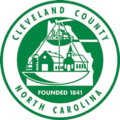Cleveland County, North Carolina | |
|---|---|
 Cleveland County Courthouse | |
| Motto(s): "Live, Work and Play in Cleveland County" | |
 Location within the U.S. state of North Carolina | |
 Interactive map of Cleveland County, North Carolina | |
| Coordinates: 35°20′N81°34′W / 35.33°N 81.56°W | |
| Country | |
| State | |
| Founded | 1841 |
| Named after | Benjamin Cleveland |
| Seat | Shelby |
| Largest community | Shelby |
| Area | |
• Total | 468.18 sq mi (1,212.6 km2) |
| • Land | 464.25 sq mi (1,202.4 km2) |
| • Water | 3.93 sq mi (10.2 km2) 0.84% |
| Population (2020) | |
• Total | 99,519 |
• Estimate (2024) | 102,194 |
| • Density | 214.37/sq mi (82.767/km2) |
| Time zone | UTC−5 (Eastern) |
| • Summer (DST) | UTC−4 (EDT) |
| Congressional district | 14th |
| Website | www |
Cleveland County is a county located in the foothills of the Blue Ridge Mountains and the western Piedmont, on the southern border of the U.S. state of North Carolina. As of the 2020 census, the population was 99,519. [1] Its county seat is Shelby. [2] Cleveland County comprises the Shelby-Kings Mountain, NC Micropolitan Statistical Area, which is also included in the Charlotte-Concord, NC-SC Combined Statistical Area. [3]
Contents
- History
- Geography
- State and local protected areas
- Major water bodies
- Adjacent counties
- Major highways
- Major infrastructure
- Demographics
- 2020 census
- 2010 census
- Government and politics
- Education
- Cleveland County Schools
- Post-secondary
- Communities
- Cities
- Towns
- Census-designated place
- Unincorporated communities
- Townships
- Notable people
- In popular culture
- See also
- References
- External links





